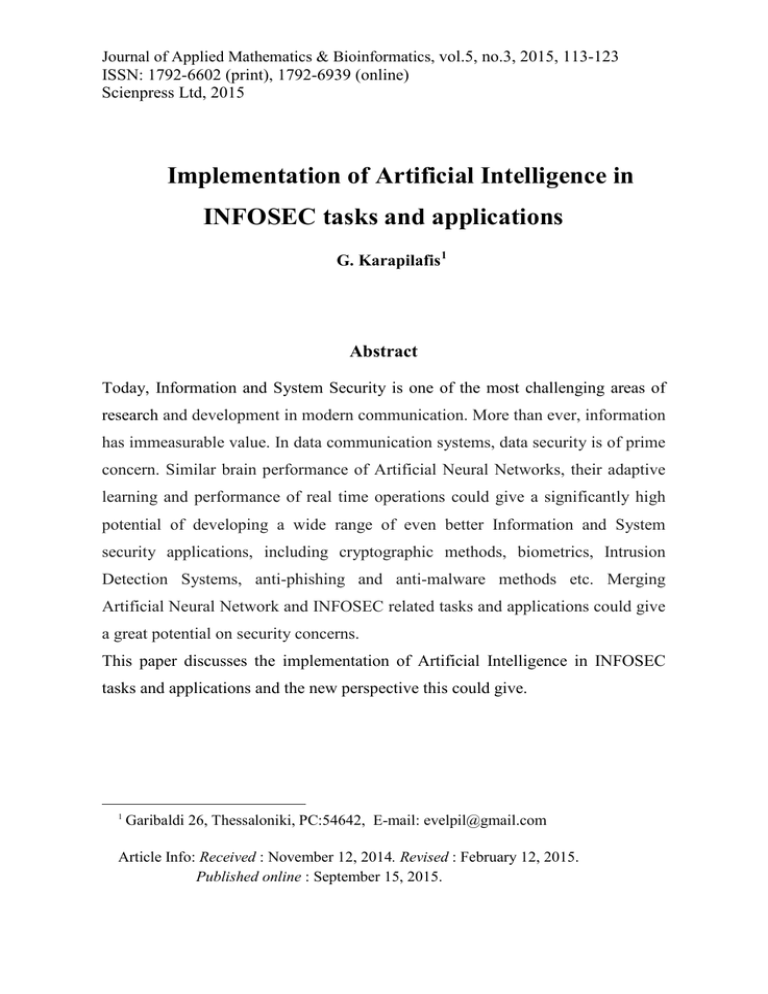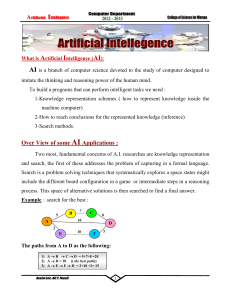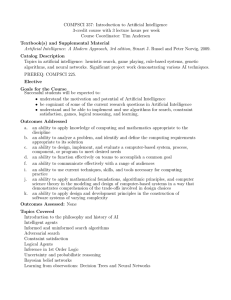
Journal of Applied Mathematics & Bioinformatics, vol.5, no.3, 2015, 113-123
ISSN: 1792-6602 (print), 1792-6939 (online)
Scienpress Ltd, 2015
Implementation of Artificial Intelligence in
INFOSEC tasks and applications
G. Karapilafis 1
Abstract
Today, Information and System Security is one of the most challenging areas of
research and development in modern communication. More than ever, information
has immeasurable value. In data communication systems, data security is of prime
concern. Similar brain performance of Artificial Neural Networks, their adaptive
learning and performance of real time operations could give a significantly high
potential of developing a wide range of even better Information and System
security applications, including cryptographic methods, biometrics, Intrusion
Detection Systems, anti-phishing and anti-malware methods etc. Merging
Artificial Neural Network and INFOSEC related tasks and applications could give
a great potential on security concerns.
This paper discusses the implementation of Artificial Intelligence in INFOSEC
tasks and applications and the new perspective this could give.
1
Garibaldi 26, Thessaloniki, PC:54642, E-mail: evelpil@gmail.com
Article Info: Received : November 12, 2014. Revised : February 12, 2015.
Published online : September 15, 2015.
114
Implementation of Artificial Intelligence in INFOSEC tasks
Mathematics Subject Classification: 62M45
Keywords: Information Security; Artificial Intelligence; Artificial Neural
Networks
1 Introduction
Artificial Intelligence is a term for which many descriptions have been given
for. One of the most successful ones might be the following: “Artificial
Intelligence is the attitude of a machine, that if it could be noticed to a human, it
could justify its characterizations as intelligent” (Turban, Aronson, 1998). “The
following could be considered as signs of intelligence:
-The knowledge ability or comprehension through experiences
-The export of results through contrasting or fuzzy elements
-The successful reaction in new situations
- The usage of a knowledge mechanism in troubleshooting
- The ability of thinking and exporting results
- The ability in recognition of specific elements’ significance in a situation” [1].
Generally, an Intelligent Information System can demonstrate a behavior
similar to human intelligence like learning, self-evaluating their results and taking
decisions depending on imperfect, fuzzy or minimal data. Such, Intelligent
Systems have been used by many fields as diverse as engineering, medicine,
business and achieved many successes and as it seems in Information Security
Industry, which deals every day with the necessity of immediate assessment of the
riskiness of certain factors, usually in a fuzzy complicated environment with a
limited disposal of data, which is a task that might be undertaken well by the
above-mentioned intelligent systems.
G. Karapilafis
115
2 Neural Networks and Cluster Analysis
2.1 Artificial Neural Network Function
It is not the scope of this paper to deeply explain the function of Neural
Networks, but it is considered as necessary to have a look at some basic principles.
Neural Networks’ function is inspired from the construction and function of the
human brain and its basic element, the neural, which builds a thick communication
network between them. An Artificial Neural Network is a network that is initially
trained and large amounts of data and rules are feed as input to it. It is the same as
the brain performs a particular function. It consists of a pool of simple processing
units which communicate by sending signals to each other over a large number of
weighted connections.
Figure1: Representation of a neural network
The network has to be trained so that the set of inputs produces the desired set of
outputs. This connection list model gives the opportunity to create intelligent
algorithms and procedures related with intelligence such as learning, memory,
generalization and pattern batch. This model also produces computational power.
Through the training process, the evaluation, the choice of the structure of the
neural network, the training functions and many other factors and since we
116
Implementation of Artificial Intelligence in INFOSEC tasks
previously know which result we want to have, we can end up having trained
neural networks for specific tasks which produce logical results when we present
them with new, first-seen data. Artificial Neural Networks, as humans, learn by
examples. They have the ability to derive meaningful data from complex dataset
and can be used to mine patterns that are too difficult for humans to be noticed.
Some of their advantages may be considered the following:
-
Nonlinearity: We can model classification problems where the output values
are not directly related to its input
-
Adaptive: Neural Networks can adjust the weights based on the changes of
its surrounding environments
-
Generalization: Neural Networks are able to find the suitable output for the
inputs that does not exist in the training data
Researchers have already managed to build software that takes advantage of
Neural Network characteristics and perform functions similar of a human brain,
like voice and face recognition, autonomous navigation, decision making, logic,
building a strategy and of course functions that are applicable to Information
Security.
2.2 Neural Network characteristics and applicability to INFOSEC
As Information and System Security and Artificial Intelligence are two fields
of science that by their definitions and their associated applications are
complicated and multidimensional it is difficult to provide in a single paper all the
perspectives that the combination of the above mentioned fields could give. For
that reason only some basic characteristics of Artificial Neural Networks and a
limited number of examples will be presented in this paper and not so analytical
and specific results that researches have given so far.
G. Karapilafis
117
One neural networks’ feature that is suitable for security design is considered
its learning ability. Given a specific task to solve, neural network can use a set of
observations to solve this task in an optimal sense. There are two existing methods
of how we can train a Neural Network. The supervised and the unsupervised
learning method.
In supervised training both the inputs and the outputs are provided. The
network then processes the inputs and compares its resulting outputs against the
desired outputs. Errors then are propagated back through the system, causing the
system to adjust the weights which control the network. There are commercial
network development packages that provide tools to monitor how well an artificial
neural network is converging on the ability to predict the right answer. These tools
allow the training process to go on for days stopping only when the system
reaches some statistically desired point, or accuracy. When finally the system has
correctly been trained the weights can, if desired, be frozen. In some systems this
finalized network is then turned into hardware. Other systems do not lock
themselves in, but continue learning while in production use. As building a secure
system and allowing its access with strong passwords is of a prime concern, the
above mentioned learning method could be taken as an advantage to build another
authentication mechanism for password based systems. By training an Artificial
Neural Network to recognize one specific password as the right one and by
limiting the errors of this process near to 0 values, a unique network with unique
values is created. These specific values could be used each time as the
authentication ticket. This method gives another important advantage to the user.
Using different strong passwords that are changed in reasonable time periods for
the different systems or networks we use, is considered as the most secure way to
protect our data from disclosure but at the same time is the one that demands big
effort for the user to remember. That also could me changed by using Artificial
Neural Networks in the security design of our systems. That is justified by the fact
that every time we train a neural network to recognize a specific password, we are
118
Implementation of Artificial Intelligence in INFOSEC tasks
taking back different values for that very same password. This feature could
facilitate users and could let them use the same password for all the networks and
systems they use, by just retraining the neural network for this password.
In unsupervised training, the network is provided with inputs but not with
desired outputs. The system itself must then decide what features it will use to
group the data. This adaption to the environment is the promise which would
enable sophisticated software to continually learn on its own as it encounters new
situations and new environments. Such an environment is cyber defense where
security analysts and network administrators try to discover possible security
breaches to their systems. As it is said, antivirus use signature based, pattern
matching mechanisms and in most of the cases if there is not an exact known
signature for an attack the possibility of a compromise will be high and at the
same time there will be no evidence of what hit the system. Malware developers
also prove constantly by using various techniques their ability to develop malware
that remain hidden during infection and operation perfectly hiding their operation
from modern anti-malware software, which try to identify such a malicious
software by just comparing and searching for defined signatures. This happens
because criminals are constantly evolving and as it seems, this will be always a
game of the cat and the mouse between evil-motivated people and legitimate
users. The implementation in such examples of Artificial Intelligence techniques
and software would give a great boost to Information and System Security
industry. Artificial Intelligence could adapt to this environment during peace time
and prepare itself to fend against unknown threats during an attack, or speed up its
reaction time and precision when a known attack is taking place, leaving the
administrators unbothered. Decision making under uncertain conditions, where
there is lack of total knowledge and lack of time could be transformed in an easier
and less stressful process for network administrators. Most of our decisions are
taken under uncertainty with high risk since the evaluation is done with fuzzy and
incomplete information. In such a fuzzy environment Artificial Intelligence
G. Karapilafis
119
mechanisms could adapt very well and evaluate the risk every time it is needed so.
A more detailed example of such an implementation of Artificial Intelligence
is a recent research [8] that uses Evolving Spiking Neural Networks for
identifying Packed Executable and the existence of malware software, while
performing classification. Code packing is a technique used to hide malicious code
and perplex analysts' examination of it. One advantage of such an implementation
is its low need of computational power and resources compared to already existing
software where there is the need to always unpack the code if there is not
signature verified. Usage of evolving Spiking Neural Networks reported
promising results indicating the importance and the dynamics that the
implementation of Artificial Intelligence in Information Security and Assurance
could have.
Figure 2: Neural Network that consists of three levels and neurons to each level
A second feature is the one-way property that has to do with the computation
of the output from the input. In Neural Networks it is easy to compute the output
from the input, while difficult or impossible to compute the input from the output.
This can be seen in the following function (1) of a simple neuron model.
120
Implementation of Artificial Intelligence in INFOSEC tasks
n-1
C = ƒ ( Σ wjpj + b) (1)
i=0
It is easy to compute C from P, while difficult to compute P from C. This
property is often required by Hash function used for data integrity and generally in
asymmetric algorithms, which crux is that they provide security by using
mathematical equations that are easy to perform in one direction and next to
impossible to perform in the other direction. With such a characteristic of neural
networks, a password identity based security system could get a new direction of
development and also data integrity mechanisms.
2.3 Cluster Analysis
Last years there has been an effort from researches to find a meaning and a
structure inside chaotic systems. With classical statistics the effort of finding an
interconnection between the data of those systems is considered as tricky.
Cluster analysis is a term that firstly was used in 1939 from Tryon and refers
to the effort of finding specific structures inside a dataset, with the usage of some
different algorithms that aim to the classification of the data. In the following
picture is presented an example of cluster analysis.
The intension is the identification of the clusters with definite visual
separation and moreover the specification of the degree of participation of the data
to one cluster. This specification is one of the main differences between cluster
analysis (fuzzy statistics) and classical statistics. Classical statistics most of the
time cannot designate a specific value to a certain category. On the other hand
with cluster analysis a degree of participation is assigned to all data. Cluster
analysis is very useful in pattern analysis, decision making, data mining etc.
G. Karapilafis
121
X
X
X
X
X
X
X
X
X
X
X
6
7
6
6
X
6
5
5
5
X
X
6
7
7
7
6
6
X
X
X
Y-Axis
Y-Axis
6
6
X
X
X
6
6
6
6
X
3
X
X
X
X
X
X
X
X
X
X
X
X
X
X-Axis
4
3
1
1
1
4
3
2
4
3
2
2
4
X-Axis
Figure 3: An example of Cluster Analysis
Fuzzy C-Means Clustering is an algorithm that is used in cluster analysis. It
was firstly introduced from Bezdek. In general, we could say that fuzzy clustering
extends the meaning that “one data belongs to a cluster” and relates every data
with every cluster by assigning them a degree of participation to the clusters.
Figure 4: Determination of the center of the clusters
In such a way, we could take the advantages that cluster analysis gives us and
try to classify web sites for example and see how many clusters we can get and in
which of them the websites we are interested in participate more or less. Phishing
or legitimate websites could be evaluated and classified using that way, giving a
new approach of doing this.
122
Implementation of Artificial Intelligence in INFOSEC tasks
4 Discussion and Conclusions
The rapid development of computer systems and the increase of sophistication
in computer security attacks, make Artificial Intelligence a valuable field in
assuring computer security for the future. Whether Artificial Intelligence will be
used as an assistant or be used as the full time security administrator, it is highly
probable that it will be utilized in computer security since the computer systems’
world is turning to more adaptive and automated systems. The design of
intelligent information systems is considered as necessary not only in the field of
information security but also in our every day lives. Artificial Intelligence is a part
of science that has applicability in many fields. Discovering its capabilities is an
undergoing process but it has already proven that new horizons are opened as long
as the human race advances in its understanding of mathematics and as processing
power increases.
References
[1] L. Iliadis, Artificial Intelligence Systems and applications in danger
estimation, 2007.
[2] M.T. Hagan and H.B. Beale, Neural Networks Design, Boston, MA, PWS
Publishing, 1996.
[3] S. Haykin, Multilayer Perceptron in Neural Networks and Learning Machines
3rd Ed., Publishing as Pearson Prentice Hall, ch.4.pp.122-139, 2009.
[4] http://www.mathworks.com/help/toolbox/bioinfo
[5] L. Iliadis, M. Vangeloudh and S. Spartalis, An intelligent system employing
an enhanced fuzzy c-means clustering model: Application in the case of forest
fires, Computers and Electronics in Agriculture, 70(2), (2010), 276-284.
[6] V. Kecman, Learning and Soft Computing MIT, Press, USA, 2001.
G. Karapilafis
123
[7] V. Vapnik, Statistical Learning Theory, The support vector method of
function estimation, 1998.
[8] K. Demertzis and L. Iliadis, Evolving Computational Intelligence System for
Malware Detection, 2014.




